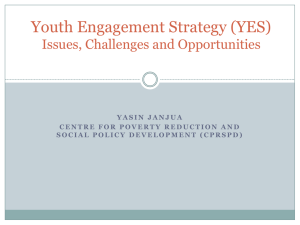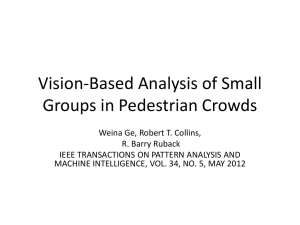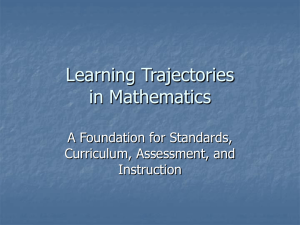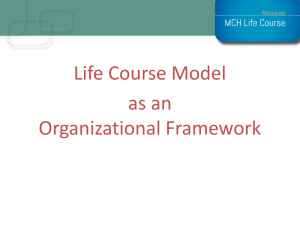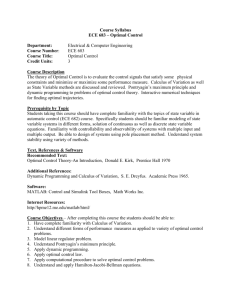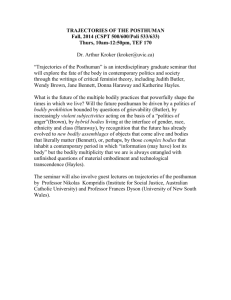Supplementary data Excited-state proton transfer reactions of 7
advertisement
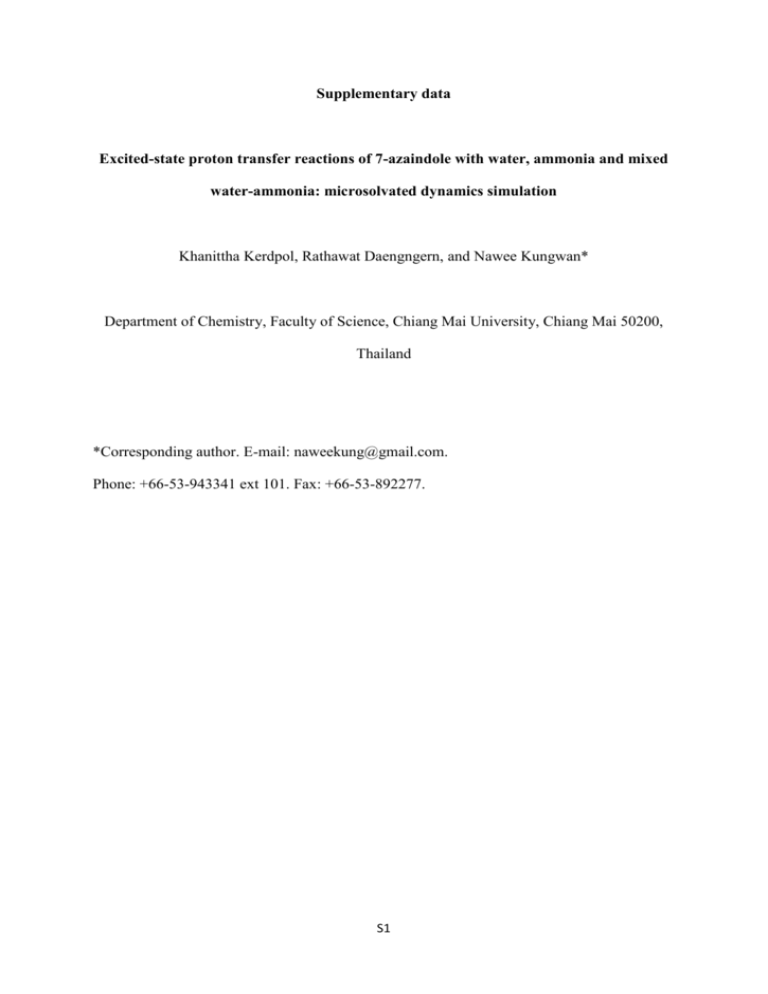
Supplementary data Excited-state proton transfer reactions of 7-azaindole with water, ammonia and mixed water-ammonia: microsolvated dynamics simulation Khanittha Kerdpol, Rathawat Daengngern, and Nawee Kungwan* Department of Chemistry, Faculty of Science, Chiang Mai University, Chiang Mai 50200, Thailand *Corresponding author. E-mail: naweekung@gmail.com. Phone: +66-53-943341 ext 101. Fax: +66-53-892277. S1 Table S1 Average relative ground (S0) and excited states (ππ*) free energies (kcal mol−1) State S0 S1 (ππ*) N IS1 IS2 IS3 IS4 T N IS1 IS2 IS3 IS4 T M 0 29 36 7AI(solvent)1 W A 0 0 40 38 41 41 MM 0 36 38 40 MW 0 32 35 37 7AI(solvent)2 WM WW WA 0 0 0 37 36 35 45 37 40 46 35 45 AW 0 31 45 41 AA 0 33 45 38 27 103 105 93 43 105 111 99 26 104 106 102 26 103 105 104 100 26 101 103 99 96 38 104 110 106 105 30 104 107 103 103 25 106 113 112 100 33 103 105 103 97 24 104 107 106 94 92 98 92 89 88 101 98 93 97 93 MMM 0 29 44 47 37 29 103 110 110 102 96 94 WWW 0 56 46 42 44 35 104 121 107 117 106 99 WWA 0 45 33 40 42 41 104 115 97 111 97 89 7AI(solvent)3 WAW WAA 0 0 40 39 47 23 49 37 53 45 48 13 103 106 117 115 115 100 109 99 110 98 95 91 AWW 0 38 52 45 50 31 104 113 111 104 111 100 AWA 0 40 28 46 57 25 109 117 102 111 105 95 AAW 0 45 47 35 46 28 105 113 110 93 98 87 AAA 0 47 47 43 32 23 104 121 114 106 94 90 For characteristic points of each complex. M-Methanol, W-Water, and A-Ammonia. Daengngern et al. J. Phys. Chem. A 2011 in 100 trajectories, Kungwan et al. 2014 submitted in 50 trajectories, Daengngern et al. J. Photochem. Photobiol. A 2013 in 25 trajectories S2 Table S2 Average time lag of the excited-state dynamics simulation Time (fs) COMPLEXES 7AI(solvent)1 7AI(solvent)2 7AI(solvent)3 PT1 Time lag PT2 Time lag PT3 Time lag PT4 7AI(M) 71 13 84 7AI(W) 48 11 59 7AI(A) 85 39 124 7AI(MM) 68 13 81 3 84 7AI(MW) 71 12 83 2 85 7AI(WM) 46 12 58 2 60 7AI(WW) 69 1 70 8 78 7AI(WA) 96 9 105 21 126 7AI(AW) 74 40 114 22 136 7AI(AA) 84 54 138 31 169 7AI(MMM) 66 11 77 6 83 1 84 7AI(WWW) 69 4 73 6 79 11 90 7AI(WWA) 51 28 79 14 93 6 99 7AI(WAW) 69 7 76 33 109 9 118 7AI(WAA) 127 20 147 39 186 57 243 7AI(AWW) 95 39 134 5 139 7 146 7AI(AWA) 95 37 132 18 150 10 160 7AI(AAW) 81 30 111 17 128 6 134 7AI(AAA) 80 53 133 22 155 20 175 Daengngern et al. J. Phys. Chem. A 2011 in 100 trajectories, Kungwan et al. 2014 submitted in 50 trajectories, Daengngern et al. J. Photochem. Photobiol. A 2013 in 25 trajectories S3 πσ* ππ* S0 Figure S1 The plot of the relative energies and possible crossing between ππ* and πσ* states for a selected 7AI(AAA) cluster. Figure S2 Ground-state optimized structure of 7AI with one ammonia cluster at RIADC(2)/SVP-SV(P) level. Dashed lines show intermolecular hydrogen-bonded network. S4 Figure S3 Snapshots representing the average over all ESTPT trajectories of the 7AI(WA) cluster dynamics showing the time evolution of the ESTPT reaction through a hydrogenbonded network within 133 fs. Normal (N), proton transfer (PT), and tautomer (T). S5 Figure S4 Average values over ESTPT trajectories of the 7AI(WA) clusters. (a) Average breaking and forming of bonds showing time evolution. N1–H1 and O1···H1 in black, O1–H2 and N''···H2 in red, and N''–H3 and N2···H3 in blue (b) Average relative energies of excited stated state (S1), ground state (S0), and energy difference of S1 and S0 state (S1-S0). S6 Figure S5 Snapshots representing the average over all ESTPT trajectories of the 7AI(AA) clusters showing the time evolution of the ESTPT reaction through a hydrogen-bonded network within 175 fs. Normal (N), proton transfer (PT), and tautomer (T). S7 Figure S6 Average values over ESTPT trajectories of the 7AI(AA) clusters. (a) Average breaking and forming of bonds showing time evolution. N1–H1 and N'···H1 in black, N'–H2 and N''···H2 in red, and N''–H3 and N2···H3 in blue (b) Average relative energies of excited stated state (S1), ground state (S0), and energy difference of S1 and S0 state (S1-S0). S8 Figure S7 Snapshots of a selected trajectory of the 7AI(AAW) cluster dynamics showing the hydrogen bond reorganization in mixed water-ammonia solvent following by ESTPT through the new hydrogen-bonded network at 400 fs. Normal (N), Proton transfer (PT), and Tautomer (T). S9 Figure S8 Snapshots of a selected trajectory of the 7AI(AAA) cluster dynamics showing the hydrogen bond reorganization in ammonias following by ESDPT through the new hydrogenbonded network at 464 fs. Normal (N), Proton transfer (PT), and Tautomer (T). S10 Figure S9 Snapshots of the 7AI(WWA) clusters dynamics showing the time evolution of the ESQPT reaction through the hydrogen-bonded network. Normal (N), Proton transfer (PT), and Tautomer (T). Values correspond to the average over all ESQPT trajectories. S11 Figure S10 Average values over ESQPT trajectories of the 7AI(WWA) clusters. (a) Average breaking and forming of bonds showing time evolution. N1–H1 and O1···H1 in black, O1–H2 and O3···H2 in red, O3–H3 and N''···H3 in blue, and N''–H4 and N2···H4 in green (b) Average relative energies of excited stated state (S1), ground state (S0), and energy difference of S1 and S0 state (S1-S0). S12 Figure S11 Snapshots of the 7AI(WAW) clusters dynamics showing the time evolution of the ESQPT reaction through the hydrogen-bonded network. Normal (N), Proton transfer (PT), and Tautomer (T). Values correspond to the average over all ESQPT trajectories. S13 Figure S12 Average values over ESQPT trajectories of the 7AI(WAW) clusters. (a) Average breaking and forming of bonds showing time evolution. N1–H1 and O1···H1 in black, O1– H2 and N'''···H2 in red, N'''–H3 and O2···H3 in blue, and O2–H4 and N2···H4 in green (b) Average relative energies of excited stated state (S1), ground state (S0), and energy difference of S1 and S0 state (S1-S0). S14 Figure S13 Snapshots of the 7AI(WAA) clusters dynamics showing the time evolution of the ESQPT reaction through the hydrogen-bonded network. Normal (N), Proton transfer (PT), and Tautomer (T). Values correspond to the average over all ESQPT trajectories. S15 Figure S14 Average values over ESQPT trajectories of the 7AI(WAA) clusters. (a) Average breaking and forming of bonds showing time evolution. N1–H1 and O1···H1 in black, O1– H2 and N'''···H2 in red, N'''–H3 and N''···H3 in blue, and N''–H4 and N2···H4 in green (b) Average relative energies of excited stated state (S1), ground state (S0), and energy difference of S1 and S0 state (S1-S0). S16 Figure S15 Snapshots of the 7AI(AWW) cluster dynamics showing the time evolution of the ESQPT reaction through the hydrogen-bonded network. Normal (N), Proton transfer (PT), and Tautomer (T). Values correspond to the average over all ESQPT trajectories. S17 Figure S16 Average values over ESQPT trajectories of the 7AI(AWW) clusters. (a) Average breaking and forming of bonds showing time evolution. N1–H1 and N'···H1 in black, N'–H2 and O3···H2 in red, O3–H3 and O2···H3 in blue, and O2–H4 and N2···H4 in green (b) Average relative energies of excited stated state (S1), ground state (S0), and energy difference of S1 and S0 state (S1-S0). S18 Figure S17 Snapshots of the 7AI(AWA) cluster dynamics showing the time evolution of the ESQPT reaction through the hydrogen-bonded network. Normal (N), Proton transfer (PT), and Tautomer (T). Values correspond to the average over all ESQPT trajectories. S19 Figure S18 Average values over ESQPT trajectories of the 7AI(AWA) clusters. (a) Average breaking and forming of bonds showing time evolution. N1–H1 and N'···H1 in black, N'–H2 and O3···H2 in red, O3–H3 and N''···H3 in blue, and N''–H4 and N2···H4 in green (b) Average relative energies of excited stated state (S1), ground state (S0), and energy difference of S1 and S0 state (S1-S0). S20 Figure S19 Snapshots of the 7AI(AAA) cluster dynamics showing the time evolution of the ESQPT reaction through the hydrogen-bonded network. Normal (N), Proton transfer (PT), and Tautomer (T). Values correspond to the average over all ESQPT trajectories. S21 Figure S20 Average values over ESQPT trajectories of the 7AI(AAA) clusters. (a) Average breaking and forming of bonds showing time evolution. N1–H1 and N'···H1 in black, N'–H2 and N'''···H2 in red, N'''–H3 and N''···H3 in blue, and N''–H4 and N2···H4 in green (b) Average relative energies of excited stated state (S1), ground state (S0), and energy difference of S1 and S0 state (S1-S0). S22 Figure S21 Average relative energies (kcal.mol-1) of the ground (S0) and the excited states (ππ*) of 7AI(solvent)1: 7AI(M), 7AI(W) and 7AI(A). S23 Figure S22 Average relative energies (kcal.mol-1) of the ground (S0) and the excited states (ππ*) of 7AI(solvent)2: 7AI(MM), 7AI(MW), 7AI(WM), 7AI(WW), 7AI(WA), 7AI(AW) and 7AI(AA). S24 Figure S23 Average relative energies (kcal.mol-1) of the ground (S0) and the excited states (ππ*) of 7AI(solvent)3: 7AI(MMM), 7AI(WWW), 7AI(WWA), 7AI(WAW), 7AI(WAA), 7AI(AWW), 7AI(AWA), 7AI(AAW) and 7AI(AAA). S25

